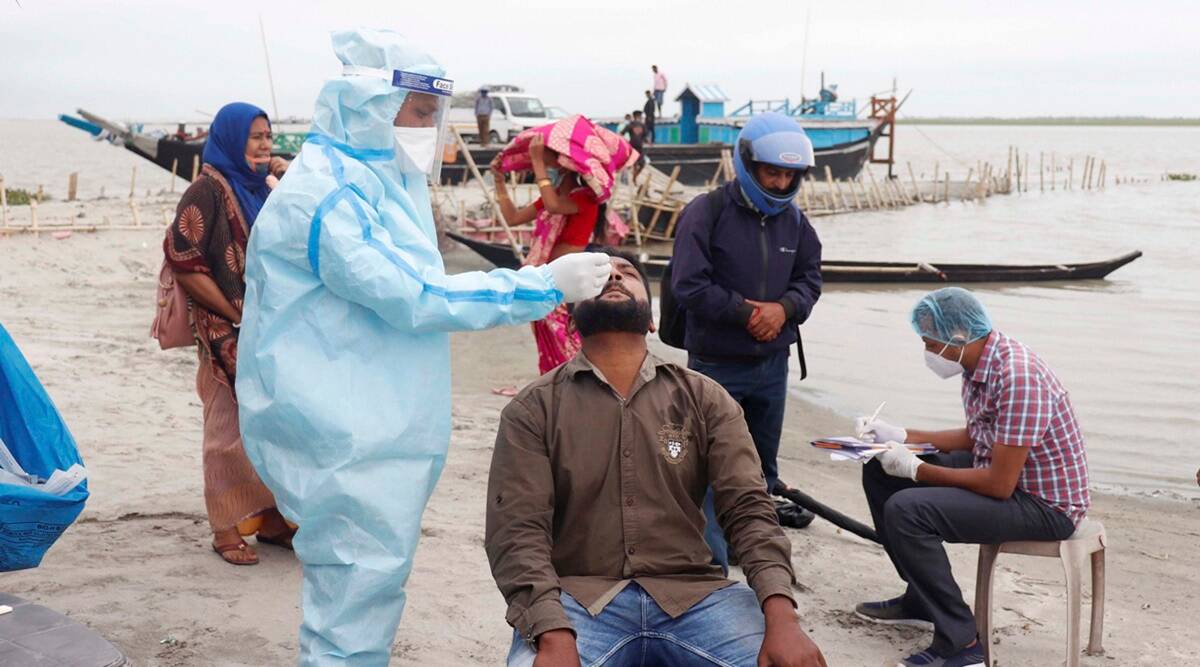As rural areas see a rise in Covid-19 cases, the Centre on Sunday issued new guidelines for containment of the virus advising that peri-urban and rural areas plan a minimum 30-bed Covid Care Centre for asymptomatic cases with comorbidities or mild cases where home isolation is not feasible.
Provision of Rapid Antigen Test (RAT) kits should be made at all public health facilities including sub-centres or health and wellness centres and Primary Health Centres, the Union Health Ministry said.
Noting that besides urban areas reporting a large number of cases, a gradual ingress is now being seen in peri-urban, rural and tribal areas as well, the ministry released the ‘SOP on Covid-19 Containment and Management in Peri-urban, Rural & Tribal areas’ to enable communities strengthen primary level healthcare infrastructure at all levels to intensify Covid-19 response.
It said Covid Care Centres (CCC) can admit a suspect or confirmed case but should have separate areas for suspected and confirmed cases with preferably separate entry and exit for each.
“Suspect and confirmed cases should not be allowed to mix under any circumstances,” the SOP said.
 A health worker collects swab samples in Jammu. (PTI)
A health worker collects swab samples in Jammu. (PTI)
According to the SOP, in every village, active surveillance should be done for influenza-like illness/ severe acute respiratory infections (ILI/SARI) periodically by ASHA with help of Village Health Sanitation and Nutrition Committee (VHSNC).
Symptomatic cases can be triaged at village level by tele-consultation with Community Health Officer (CHO), and cases with comorbidity or low oxygen saturation should be sent to higher centres.
Identified suspected Covid cases should link for testing to health facilities either through Covid-19 rapid antigen testing or by referral of samples to nearest Covid -19 testing laboratory, in accordance with ICMR guidelines.
CHOs and ANMs should be trained in performing Rapid Antigen Testing. Provision of RAT kits should be made at all public health facilities including Sub-centres, Health and Wellness Centres and Primary Health Centres, the document said.
Depending upon the intensity of surge and number of cases, as far as feasible, contact tracing should be done as per Integrated Disease Surveillance Programme’s (IDSP’s) guidelines, it stated.
“Nearly 80-85 per cent Covid -19 cases are asymptomatic/ mildly symptomatic. These patients do not require hospitalisation and may be managed at home or in Covid care isolation facilities,” the SOP stated.
As monitoring of oxygen saturation is important for monitoring of Covid patients, it is desirable for each village to have adequate number of pulse oximeters and thermometers.
The SOP recommended developing a system of providing pulse oximeters and thermometers on loan to families with a confirmed case of Covid through ASHA/ Anganwadi workers and village-level volunteers.
Pulse oximeters and thermometers should be sanitised after each use with cotton or cloth soaked in alcohol-based sanitiser.
Follow-ups for patients undergoing isolation or quarantine could be done through household visits by a frontline worker/ volunteers/ teacher duly following required infection prevention practices including use of medical mask and other appropriate precautions.
“Home Isolation kit shall be provided to all such cases which should include required medicines such as Paracetamol 500 mg, Tab. Ivermectin, cough syrup, multivitamins (as prescribed by the treating doctor) besides a detailed pamphlet indicating precautions to be taken, medication details, monitoring proforma for patient condition during home isolation, contact details in case of any major symptoms or deterioration of health condition and the discharge criteria,” the SOP stated.
The health infrastructure planned for peri-urban, rural and tribal areas shall be aligned to the already mentioned 3-tier structure – Covid Care Centre (CCC) to manage mild or asymptomatic cases, Dedicated COVID Health Centre (DCHC) to manage moderate cases and Dedicated Covid Hospital (DCH) to manage severe cases, according to the document.
The CCCs are makeshift facilities under the supervision of nearest PHC/CHC and may be set up in schools, community halls, marriage halls, panchayat buildings in close proximity of hospitals or healthcare facilities, or tentage facilities in panchayat land, school ground, etc.
These CCCs should be mapped to one or more Dedicated Covid Health Centres and at least one Dedicated Covid Hospital for referral purposes.
Such Covid care centres should also have a Basic Life Support Ambulance (BLSA) networked among such CCCs equipped with sufficient oxygen support on 24×7 basis, for ensuring safe transport of patients to dedicated higher facilities if the symptoms progress from mild to moderate or severe.
Primary Health Centres or Community Health Centres and Sub District Hospitals in these areas shall be the Dedicated Covid Health Centre for management of Covid -19. The facility may plan a minimum of 30 bedded DCHC. District should be prepared to increase DCHC beds as per the case trajectory and expected surge of cases, the document stated.
These centres shall offer care for all cases that have been clinically assigned as moderate (Patient breathless; Respiratory Rate more than 24 per minute; Saturation between 90 to <94% on room air).
District hospitals or other identified private hospitals or a block of these hospitals shall be converted as dedicated Covid Hospitals.
In addition, sub-district or block level hospitals fulfilling the requirements may also be designated as dedicated Covid hospitals for the identified CCC and DHCC in their catchment area. The upgradation in health facilities shall be undertaken based on case trajectory or the surge in cases, the SOP stated.



